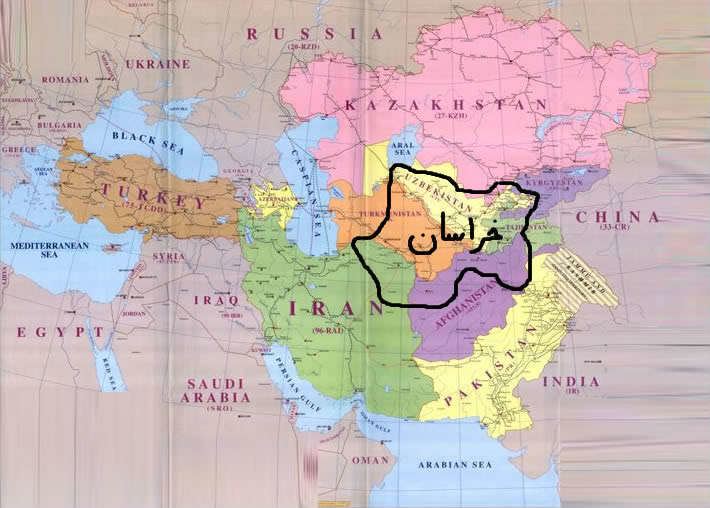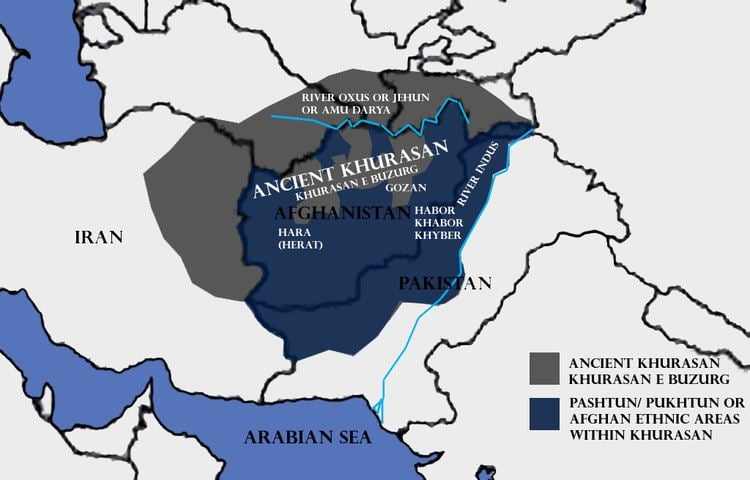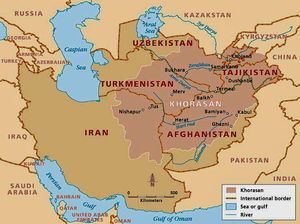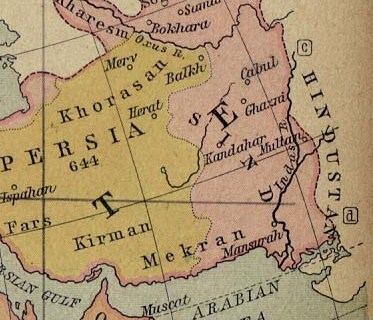 | ||
Similar Transoxiana , Isfahan , Balkh | ||
Greater khorasan tajikan samarqand bukhara afg tajikistan
Khorasan (Middle Persian: , Persian: خراسان Xorāsān/Xorâsân listen ) is a historical region lying in the northeast of Persia. But in pre-Islamic and early Islamic times, the term "Khurassan" frequently had a much wider denotation, covering also parts of Central Asia and Afghanistan; early Islamic usage often regarded everywhere east of western Persia, so-called Jibal or what was subsequently termed 'Irak 'Adjami, as being included in a vast and ill-defined region of Khurasan, which might even extend to the Indus Valley and Sind.
Contents
- Greater khorasan tajikan samarqand bukhara afg tajikistan
- Name
- Geographical distribution
- History
- Sasanian era
- Islamic Invasion
- Cultural importance
- Demographics
- References

Khorasan in its proper sense comprised principally the cities of Balkh and Herat (now in Afghanistan), Mashhad and Nishapur (now in northeastern Iran), Merv and Nisa (now in southern Turkmenistan), and Bukhara and Samarkand (now in Uzbekistan). Some believe that at certain times Khorasan covered a wider area, which included parts of Transoxiana, Soghdiana, Sistan, and extended to the boundaries of the Indian subcontinent. When the Arabs first arrived to the southern Hindu Kush to defeat the Zunbils, they recognized it as al-Hind (Sind), owing to the prevalence of Buddhists and Hindus (non-Zoroastrians) due to its cultural connection with Greater India. Sources from the 14th to the 16th century report that areas in the south of the Hindu Kush mountain range (Zamindawar, Balochistan, and Kabulistan) formed a frontier between Khorasan and Hindustan.
In the Islamic period, Persian Iraq and Khorasan were the two important territories. The boundary between these two was the region surrounding the cities of Gurgan and Qumis (modern Damghan). In particular, the Ghaznavids, Seljuqs, and Timurids divided their empires into Iraqi and Khorasani regions. The adjective Greater is added these days to distinguish the historical region from the Khorasan Province of Iran, which roughly encompassed the western half of the historical Greater Khorasan.

Name

The name "Khorāsān" is derived from Middle Persian Khwarāsān (), a compound of khwar (meaning "sun") and āsān (from āyān, literally meaning "to come" or "coming" or "about to come"). Thus the name Khorasan (or Khorāyān خورآيان) means "land where the sun rises" or "east". The Persian word Khāvar-zamīn (Persian: خاور زمین), meaning "the eastern land", has also been used as an equivalent term.
Geographical distribution

First established as a political entity by the Sassanids, the borders of the region have varied considerably during its 1,600-year history. Initially the Khorasan province of Sassanid empire included the cities of Nishapur, Herat, Merv, Faryab, Taloqan, Balkh, Bukhara, Badghis, Abiward, Gharjistan, Tus or Susia, Sarakhs and Gurgan. In addition to these cities, Ibn Khordadbeh mentions the cities of Nasā, Marvrud, Zabulistan, Kabul, Termez, Bamyan, Sogdia, Farghana, Rivsharan, Jowzjan, Khwarazm, Khotl, Osrushana, Sajistan, Pushang, Kesh, Botam, Vardana, Gorgan and Transoxiana as part of Khurasan. So according to him, eastern parts of today Iran, the entire Afghanistan, Turkmenistan, Uzbekistan, Tajikistan, Kyrgyzstan, southern parts of Kazakhstan, northwestern regions of China (Xinjiang), and the Indus Valley were part of Khurasan.

It acquired its greatest extent under the Caliphs, for whom "Khorasan" was the name of one of the three political zones under their dominion (the other two being Eraq-e Arab "Arabic Iraq" and Eraq-e Ajam "Non-Arabic Iraq or Persian Iraq"). Under the Umayyad and Abbasid caliphates, Khorasan was divided into four major sections or quarters (rub′), each section based on a single major city: Nishapur, Merv, Herat and Balkh.
In the Middle Ages, the term was loosely applied in Persia to all its territories that lay east and north east of Dasht-e Kavir and therefore were subjected to change as the size of empire changed. According to Ghulam Mohammad Ghobar, Afghanistan's current Persian-speaking territories formed the major portion of Khorasan, as two of the four main capitals of Khorasan (Herat and Balkh) are now located in Afghanistan. Ghobar uses the terms "Proper Khorasan" and "Improper Khorasan" in his book to distinguish between the usage of Khorasan in its strict sense and its usage in a loose sense. According to him, Proper Khorasan contained regions lying between Balkh in the east, Merv in the north, Sistan in the south, Nishapur in the west and Herat, known as the Pearl of Khorasan, in the center. Improper Khorasan's boundaries extended to as far as Hazarajat and Kabul in the east, Sistan and Baluchistan in the south, Transoxiana and Khwarezm in the north, and Damghan and Gorgan in the west. It is mentioned in the Memoirs of Babur that:
"The people of Hindustān call every country beyond their own Khorasān, in the same manner as the Arabs term all except Arabia, Ajem. On the road between Hindustān and Khorasān, there are two great marts: the one Kābul, the other Kandahār. Caravans, from Ferghāna, Tūrkestān, Samarkand, Balkh, Bokhāra, Hissār, and Badakhshān, all resort to Kābul; while those from Khorasān repair to Kandahār. This country lies between Hindustān and Khorasān."
History
History of Iran, History of Turkmenistan, History of Afghanistan, History of Uzbekistan, History of Tajikistan
Before the region fell to Alexander the Great in 330 BC, it was part of the Persian Achaemenid Empire and prior to that it was occupied by the Medes. Following Alexander's brief occupation, the successor state of the Seleucid Empire controlled the area until 305 BCE when they gave south of the Hindu Kush to the Indian Maurya Empire as part of an alliance treaty.
"Alexander took these away from the Aryans and established settlements of his own, but Seleucus Nicator gave them to Sandrocottus (Chandragupta), upon terms of intermarriage and of receiving in exchange 500 elephants."
The land that became known as Khorasan in geography of Eratosthenes was recognized as Ariana by Greeks at that time, which made up Greater Iran or the land where Zoroastrianism was the dominant religion. The southeastern region of Khorasan fell to the Kushan Empire in the 1st century AD. The Kushan rulers built a capital in modern-day Afghanistan at Bagram and are believed to have built the famous Buddhas of Bamiyan. Numerous Buddhist temples and buried cities have been found in Afghanistan. However, the region of Khorasan remained predominantly Zoroastrian but there were also Manichaeists, sun worshippers, Christians, Pagans, Shamanists, Buddhists, Jews and others. One of the three great fire-temples of the Sassanids "Azar-burzin Mehr" is situated near Sabzevar in Iran. The boundary of the region began changing until the Kushans and Sassanids merged to form the Kushano-Sassanian civilization.
Sasanian era
During the Sasanian era, likely in the reign of Khusrow I, Persia was divided into four regions (known as kust Middle Persian), Khwārvarān in the west, apāxtar in the north, nīmrūz in the south and Khurasan in the east. Since the Sasanian territories were more or less remained stable up to Islamic conquests, it ca. be concluded that Sasanian Khorasan was bordered to the south by Sistan and Kerman, to the west by the central deserts of modern Iran, and to the east by China and India.
In Sasanian era, Khurasan was further divided into four smaller regions, and each region was ruled by a marzban. These four regions were Nishapur, Marv, Herat and Balkh.
Khorasan in the east saw some conflict with the Hephthalites who became the new rulers in the area but the borders remained stable. Being the eastern parts of the Sassanids and further away from Arabia, Khorasan region was conquered after the remaining Persia. The last Sassanid king of Persia, Yazdgerd III, moved the throne to Khorasan following the Arab invasion in the western parts of the empire. After the assassination of the king, Khorasan was conquered by Arab Muslims in 647 AD. Like other provinces of Persia it became one of the provinces of Umayyad dynasty.
Islamic Invasion
The first movement against the Arab invasions was led by Abu Muslim Khorasani between 747 and 750. He helped the Abbasids come to power but was later killed by Al-Mansur, an Abbasid Caliph. The first independent kingdom from Arab rule was established in Khorasan by Tahir Phoshanji in 821, but it seems that it was more a matter of political and territorial gain. Tahir had helped the Caliph subdue other nationalistic movements in other parts of Persia such as Maziar's movement in Tabaristan.
Other major independent dynasties who ruled over Khorasan were the Saffarids from Zaranj (861–1003), Samanids from Bukhara (875–999), Ghaznavids from Ghazni (963–1167), Seljuqs (1037–1194), Khwarezmids (1077–1231), Ghurids (1149–1212), and Timurids (1370–1506). It should be noted that some of these dynasties were not Persian by ethnicity. The periods of Turkic Ghaznavids and Turco-Mongol Timurids are considered as some of the most brilliant eras of Khorasan's history. During these periods, there was a great cultural awakening. Many famous poets, scientists and scholars lived in this area. Numerous valuable works in Persian literature were written.
Between the early 16th and early 18th centuries, parts of Khorasan were contested between the Safavids and the Uzbeks. A part of the Khorasan region was conquered in 1722 by the Ghilji Pashtuns from Kandahar and became part of the Hotaki dynasty from 1722 to 1729. Nader Shah recaptured Khorasan in 1729 and chose Mashhad as the capital of Persia. Following his assassination in 1747, the eastern parts of Khorasan, including Herat was annexed with the Durrani Empire. Mashhad area was under control by Nader Shah's grandson Shahrukh Afshar until it was captured by Qajar dynasty in 1796, in addition to Herat. In the Treaty of Paris, which was signed between Iran and British Empire to end the Anglo-Persian War, Iranian troops agreed to withdraw from Herat in 1857. Later, in 1881, Iran relinquished its claims to a part of the northern areas of Khorasan to the Russian Empire, principally comprising Merv, by the Treaty of Akhal (also known as the Treaty of Akhal-Khorasan).
Cultural importance
Khorasan has had a great cultural importance among other regions in Greater Iran. The literary New Persian language developed in Khorasan and Transoxiana and gradually supplanted the Parthian language. The New Persian literature arose and flourished in Khorasan and Transoxiana where the early Iranian dynasties such as Tahirids, Samanids and Ghaznavids were based.The early Persian poets such as Rudaki, Shahid Balkhi, Abu al-Abbas Marwazi, Abu Hafas Sughdi, and others were from Khorasan. Moreover, Ferdowsi and Rumi were also from Khorasan.
Until the devastating Mongol invasion of the thirteenth century, Khorasan remained the cultural capital of Persia. It has produced scientists such as Avicenna, Al-Farabi, Al-Biruni, Omar Khayyám, Al-Khwarizmi, Abu Ma'shar al-Balkhi (known as Albumasar or Albuxar in the west), Alfraganus, Abu Wafa, Nasir al-Din al-Tusi, Sharaf al-Dīn al-Ṭūsī, and many others who are widely well known for their significant contributions in various domains such as mathematics, astronomy, medicine, physics, geography, and geology. Khorasan artisans contributed to the spread of technology and goods along the ancient trade routes and decorative objects have been traced to this ancient culture, including art objects, textiles and metalworks. Decorative antecedents of the famous "singing bowls" of Asia may have been invented in ancient Khorasan.
In Islamic theology, jurisprudence and philosophy, and in Hadith collection, many of the greatest Islamic scholars came from Khorasan, namely Ahmad ibn Hanbal, Abu Hanifa, Imam Bukhari, Imam Muslim, Abu Dawood, Al-Tirmidhi, Al-Nasa'i, Al-Ghazali, Al-Juwayni, Abu Mansur Maturidi, Fakhruddin al-Razi, and others. Shaykh Tusi, a Shi'a scholar and Al-Zamakhshari, the famous Mutazilite scholar, also lived in Khorasan.
Demographics
The Persians appear to have been the first ethnic group to populate the region, but they began mixing with an increasing number of foreign invaders and as a result their proportionate number was reduced. Significant immigrants such as Arabs from the west since the 7th century and Turkic peoples after the Turkic migration from the north in the Middle Ages settled in the region. After Genghis Khan conquered Persia in the 13th century, many Mongols settled in Khorasan after depopulating its cities.
